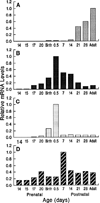Rat pancreatic lipase and two related proteins: enzymatic properties and mRNA expression during development
- PMID: 8203536
- PMCID: PMC3523700
- DOI: 10.1152/ajpgi.1994.266.5.G914
Rat pancreatic lipase and two related proteins: enzymatic properties and mRNA expression during development
Abstract
We report the cDNA sequences of rat colipase, rat pancreatic lipase (rPL), and a rat pancreatic lipase-related protein (rPLRP). Comparison to the human PLRP cDNA suggests that the isolated clone encodes rPLRP-2. Both cDNA and a third cDNA encoding rPLRP-1 are secreted from Sf9 cells infected with recombinant baculovirus. rPL and rPLRP-2 hydrolyze triolein, 8.0 and 4.4 mumol.min-1.microgram-1, respectively. They are inhibited by bile salts, and activity is restored by (pro)colipase. PLRP-1 has barely detectable activity against triolein, even with (pro)colipase present. The pattern of mRNA expression during development in the rat reveals that all mRNA are low in the fetal rat pancreas. Both PLRP mRNA rise just before birth to a maximum 12 h after birth. They fall to low levels in the adult. In contrast, the PL mRNA is low at birth and rises rapidly during the suckling-weanling transition. In conclusion, the rat has at least three genes encoding different lipases, and these related genes have separate regulatory controls.
Figures








References
-
- Deschodt-Lanckman M, Robberecht P, Camus J, Baya C, Christophe J. Hormonal and dietary adaptation of rat pancreatic hydrolases before and after weaning. Am. J. Physiol. 1974;226:39–44. - PubMed
-
- Giller T, Buchwald P, Blum-Kaelin D, Hunziker W. Two novel human pancreatic lipase related proteins, hPLRP1 and hPLRP2. J. Biol. Chem. 1992;267:16509–16516. - PubMed
-
- Grusby MJ, Nabavi N, Wong H, Dick RF, Bluestone JA, Schotz MC, Glimcher LH. Cloning of an interleukin-4 inducible gene from cytotoxic T lymphocytes and its identification as a lipase. Cell. 1990;60:451–459. - PubMed
-
- Kirchgessner TG, Chuat JC, Heinzmann C, Etienne J, Guilhot S, Svenson K, Ameis D, Pilon C, D’Auriol L, Andalibi A, Schotz MC, Galibert F, Lusis AJ. Organization of the human lipoprotein lipase gene and evolution of the lipase gene family. Proc. Natl. Acad. Sci. USA. 1989;86:9647–9651. - PMC - PubMed
Publication types
MeSH terms
Substances
Associated data
- Actions
- Actions
Grants and funding
LinkOut - more resources
Full Text Sources
Medical
Molecular Biology Databases
Miscellaneous

